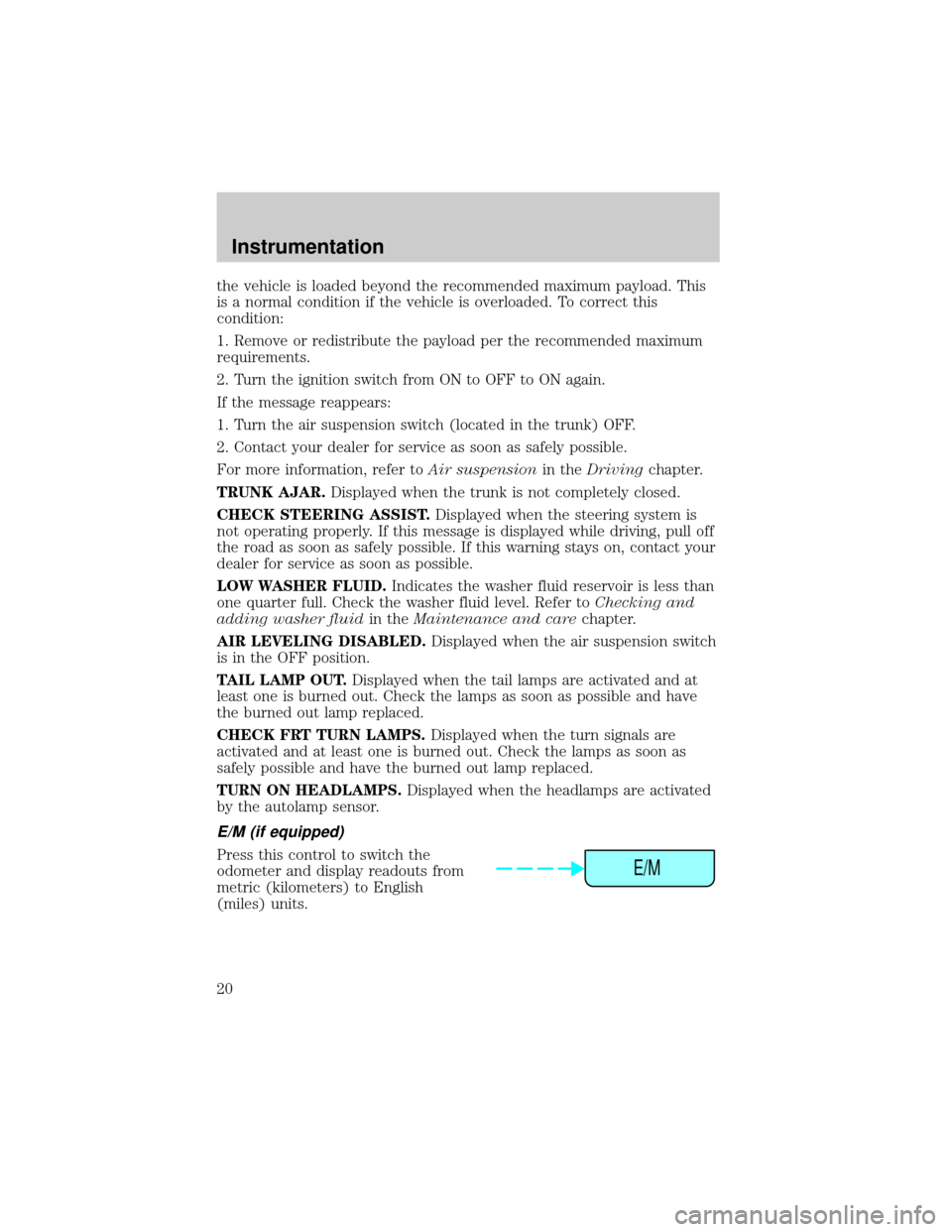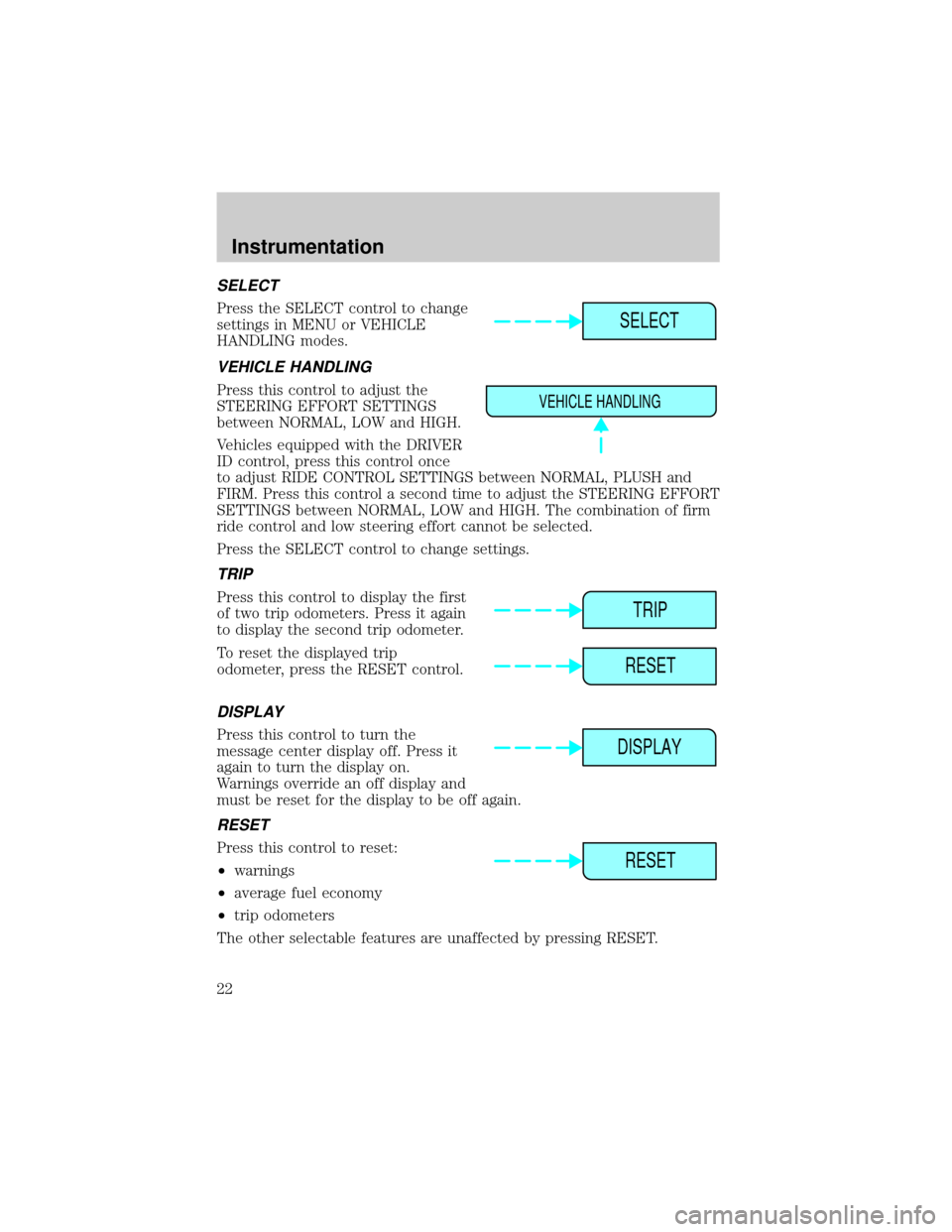2001 LINCOLN CONTINENTAL odometer
[x] Cancel search: odometerPage 13 of 224

Speedometer
Indicates the current vehicle speed.
Odometer
The odometer is located in the message center. It registers the total
kilometers (miles) of the vehicle. Pressing the E/M control (if equipped)
will alternate between English (miles) and Metric (kilometers)
measurements.
Tachometer
Indicates the engine speed in
revolutions per minute.
Driving with your tachometer
pointer in the red zone may damage
the engine.
Engine coolant temperature gauge
Indicates the temperature of the
engine coolant. At normal operating
temperature, the needle remains
within the normal area (the area
between the ªHº and ªCº). If it
enters the red section, the engine is
overheating. Stop the vehicle as
soon as safely possible, switch off
the engine immediately and let the
engine cool. Refer toEngine
coolantin theMaintenance and carechapter.
80
MPH km/h0 2060
80
100
1200 204060100
120
140
160
180
200
40
ABS
RPMx1000AIR
BAG0 123456
7
NORM
CH
Instrumentation
13
Page 20 of 224

the vehicle is loaded beyond the recommended maximum payload. This
is a normal condition if the vehicle is overloaded. To correct this
condition:
1. Remove or redistribute the payload per the recommended maximum
requirements.
2. Turn the ignition switch from ON to OFF to ON again.
If the message reappears:
1. Turn the air suspension switch (located in the trunk) OFF.
2. Contact your dealer for service as soon as safely possible.
For more information, refer toAir suspensionin theDrivingchapter.
TRUNK AJAR.Displayed when the trunk is not completely closed.
CHECK STEERING ASSIST.Displayed when the steering system is
not operating properly. If this message is displayed while driving, pull off
the road as soon as safely possible. If this warning stays on, contact your
dealer for service as soon as possible.
LOW WASHER FLUID.Indicates the washer fluid reservoir is less than
one quarter full. Check the washer fluid level. Refer toChecking and
adding washer fluidin theMaintenance and carechapter.
AIR LEVELING DISABLED.Displayed when the air suspension switch
is in the OFF position.
TAIL LAMP OUT.Displayed when the tail lamps are activated and at
least one is burned out. Check the lamps as soon as possible and have
the burned out lamp replaced.
CHECK FRT TURN LAMPS.Displayed when the turn signals are
activated and at least one is burned out. Check the lamps as soon as
safely possible and have the burned out lamp replaced.
TURN ON HEADLAMPS.Displayed when the headlamps are activated
by the autolamp sensor.
E/M (if equipped)
Press this control to switch the
odometer and display readouts from
metric (kilometers) to English
(miles) units.
E/M
Instrumentation
20
Page 21 of 224

DRIVER ID (if equipped)
Press this control and use SELECT
to choose DRIVER 1 or DRIVER 2
when choosing operator selectable
features. Seat and mirror positions
and nine operator selectable features, found under the MENU and
VEHICLE HANDLING controls, will be saved to DRIVER 1 or DRIVER 2.
These will be automatically recalled when the drivers identify themselves
to the system with the remote entry transmitter (refer toBasic
Operation of Memory Profile Systemin this section) or selecting
DRIVER 1 or DRIVER 2 in the message center. When a vehicle setting is
changed, the message center will display ªSAVED TO DRIVER 1 or
DRIVER 2º for 5 seconds to confirm the change has been made. Press
the SELECT to choose ªOFFº for temporary position/setting changes
which will not be stored.
MENU
Press this control to change various
convenience settings throughout the
vehicle. Each press of the MENU
control will display the following:
²Traction control (returns to ªONº everytime vehicle is started).
²Express window (completely goes down with one touch on the power
switch).
²Auto lock (locks the doors when the vehicle reaches 5 km/h [3 mph]).
²Horn chirp (sounds horn one time whenever the doors are locked
using the remote transmitter).
²Seat access (moves seat back to aid entry/exit from the vehicle).
²Reverse mirrors (tilts the exterior mirrors downward to assist parking
using reverse).
²English/metric (changes the odometer and display readouts)
Press the SELECT control to change the settings to ON or OFF.
These settings will be saved to the vehicle not individualized settings.
Vehicles equipped with the DRIVER ID control, the settings will be saved
to DRIVER 1 or DRIVER 2.
DRIVER ID
MENU
Instrumentation
21
Page 22 of 224

SELECT
Press the SELECT control to change
settings in MENU or VEHICLE
HANDLING modes.
VEHICLE HANDLING
Press this control to adjust the
STEERING EFFORT SETTINGS
between NORMAL, LOW and HIGH.
Vehicles equipped with the DRIVER
ID control, press this control once
to adjust RIDE CONTROL SETTINGS between NORMAL, PLUSH and
FIRM. Press this control a second time to adjust the STEERING EFFORT
SETTINGS between NORMAL, LOW and HIGH. The combination of firm
ride control and low steering effort cannot be selected.
Press the SELECT control to change settings.
TRIP
Press this control to display the first
of two trip odometers. Press it again
to display the second trip odometer.
To reset the displayed trip
odometer, press the RESET control.
DISPLAY
Press this control to turn the
message center display off. Press it
again to turn the display on.
Warnings override an off display and
must be reset for the display to be off again.
RESET
Press this control to reset:
²warnings
²average fuel economy
²trip odometers
The other selectable features are unaffected by pressing RESET.
SELECT
VEHICLE HANDLING
TRIP
RESET
DISPLAY
RESET
Instrumentation
22
Page 182 of 224

²Use the same side of the same pump and have the vehicle facing the
same direction each time you fill up.
²Have the vehicle loading and distribution the same every time.
Your results will be most accurate if your filling method is consistent.
Calculating fuel economy
1. Fill the fuel tank completely and record the initial odometer reading
(in kilometers or miles).
2. Each time you fill the tank, record the amount of fuel added (in liters
or gallons).
3. After at least three to five tank fill-ups, fill the fuel tank and record
the current odometer reading.
4. Subtract your initial odometer reading from the current odometer
reading.
5. Follow one of the simple calculations in order to determine fuel
economy:
Multiply liters used by 100, then divide by total kilometers
traveled.
Divide total miles traveled by total gallons used.
Keep a record for at least one month and record the type of driving (city
or highway). This will provide an accurate estimate of the vehicle's fuel
economy under current driving conditions. Additionally, keeping records
during summer and winter will show how temperature impacts fuel
economy. In general, lower temperatures give lower fuel economy.
Driving style Ð good driving and fuel economy habits
Give consideration to the lists that follow and you may be able to change
a number of variables and improve your fuel economy.
Habits
²Smooth, moderate operation can yield up to 10% savings in fuel.
²Steady speeds without stopping will usually give the best fuel
economy.
²Idling for long periods of time (greater than one minute) may waste
fuel.
²Anticipate stopping; slowing down may eliminate the need to stop.
Maintenance and care
182
Page 207 of 224

If you own a Lincoln vehicle and are away from home when your vehicle
needs service, or if you need more help than the dealership could
provide, after following the steps described above, contact the Ford
Customer Relationship Center to find an authorized dealership to help
you. In the United States:
Ford Motor Company
Customer Relationship Center
16800 Executive Plaza Drive
P.O. Box 6248
Dearborn, Michigan 48121
1-800-521-4140
(TDD for the hearing impaired: 1-800-232-5952)
In Canada:
Customer Relationship Centre
Ford Motor Company of Canada, Limited
P.O. Box 2000
Oakville, Ontario L6J 5E4
1-800-565-3673 (FORD)
In order to help you service your Ford or Lincoln Mercury vehicle, please
have the following information available when contacting a Customer
Relationship Center:
²Your telephone number (home and business)
²The name of the dealer and the city where the dealership is located
²The year and make of your vehicle
²The date of vehicle purchase
²The current odometer reading
²The vehicle identification number (VIN)
If you still have a complaint involving a warranty dispute, you may wish
to contact the Dispute Settlement Board (U.S.) or the Canadian Motor
Vehicle Arbitration Plan (CAMVAP), available in all of Canada (except
Quebec).
In some states (in the U.S.) you must directly notify Ford in writing
before pursuing remedies under your state's warranty laws. Ford is also
allowed a final repair attempt in some states.
In the United States, a warranty dispute must be submitted to the
Dispute Settlement Board before taking action under the Magnuson-Moss
Warranty Act, or to the extent allowed by state law, before pursuing
Customer assistance
207
Page 220 of 224

Engine oil ..................................153
change oil soon warning,
message center .......................153
checking and adding ..............153
dipstick ....................................153
filter, specifications ........155, 200
recommendations ...................155
refill capacities ........................200
specifications ..................201±202
Exhaust fumes ..........................115
F
Floor mats ...................................69
Fluid capacities .........................200
Fuel ............................................176
calculating
fuel economy ....................23, 181
cap ...........................................178
capacity ...................................200
choosing the right fuel ...........179
comparisons with EPA fuel
economy estimates .................184
detergent in fuel .....................180
filling your vehicle
with fuel ..................176, 178, 181
filter, specifications ........180, 200
fuel filler door override ............68
fuel filler door release ..............68
fuel pump shut-off switch .....133
gauge .........................................12
improving fuel economy ........181
octane rating ...................179, 202
quality ......................................179
running out of fuel .................180
safety information relating
to automotive fuels ................176
Fuses ..................................134±135G
Garage door opener ....................57
Gas cap (see Fuel cap) ............178
Gas mileage
(see Fuel economy) .................181
Gauges .........................................12
engine coolant
temperature gauge ...................13
fuel gauge ..................................12
odometer ...................................13
speedometer .............................13
tachometer ................................13
GAWR
(Gross Axle Weight Rating) .....126
definition .................................126
driving with a heavy load ......126
location ....................................126
GVWR (Gross
Vehicle Weight Rating) .............126
calculating ...............................126
definition .................................126
driving with a heavy load ......126
location ....................................126
H
Hazard flashers .........................133
Head restraints ...........................84
Headlamps ...................................25
aiming ..............................192±194
autolamp system .......................26
bulb specifications ..................191
daytime running lights .............25
flash to pass ..............................26
high beam ...........................10, 26
replacing bulbs .......................186
turning on and off ..............10, 25
warning chime ..........................12
Index
220
Page 222 of 224

M
Message center ...............14, 16, 22
air leveling disabled .................14
air ride switch off .....................14
check air ride system ...............14
check air suspension ................14
menu button .............................21
reset button ..............................22
system check button ................16
warning messages .....................17
Mirrors .........................................57
automatic dimming
rearview mirror .........................63
cleaning ...................................196
heated ........................................67
programmable memory ............75
side view mirrors (power) .......66
Moon roof ....................................57
Motorcraft parts ................180, 200
O
Octane rating ............................179
Odometer .....................................13
Oil (see Engine oil) ..................153
Overdrive ...................................122
P
Panic alarm feature, remote
entry system ................................73
Parking brake ............................117
Parts (see Motorcraft parts) ....200
Power distribution box
(see Fuses) ...............................139
Power door locks ........................64Power steering ..................119±120
fluid, checking and adding ....162
fluid, refill capacity ................200
fluid, specifications .........201±202
R
Radio ............................................34
Relays ................................134, 140
Remote entry system ...........71±73
illuminated entry ......................75
locking/unlocking doors ...........72
opening the trunk .....................73
panic alarm ...............................73
replacement/additional
transmitters ...............................74
replacing the batteries .............73
S
Safety belts (see
Safety restraints) ............12, 87±91
Safety defects, reporting ..........217
Safety restraints ....................87±91
belt minder ...............................93
cleaning the safety belts ..96, 199
extension assembly ..................92
for adults .............................88±90
for children .............................104
lap belt ......................................91
warning light
and chime ..................9, 11, 92±93
Safety seats for children ..........105
Seat belts
(see Safety restraints) ...............87
Seats ............................................84
child safety seats ....................105
cleaning ...................................199
easy access/easyout feature ....87
Index
222